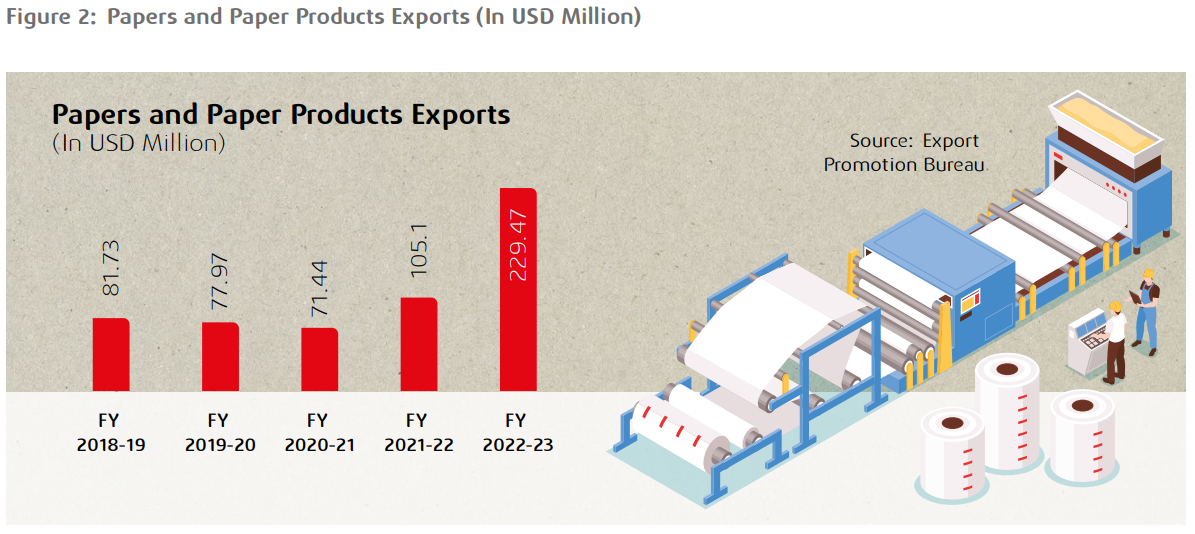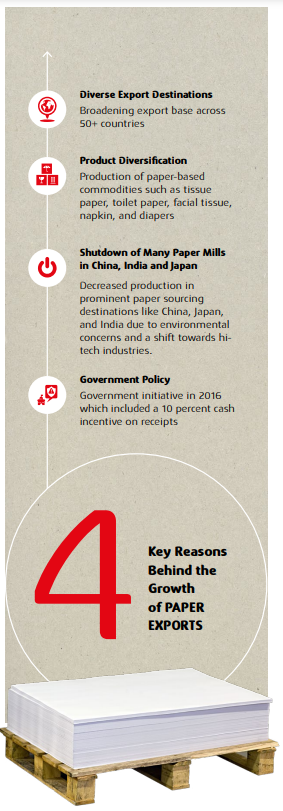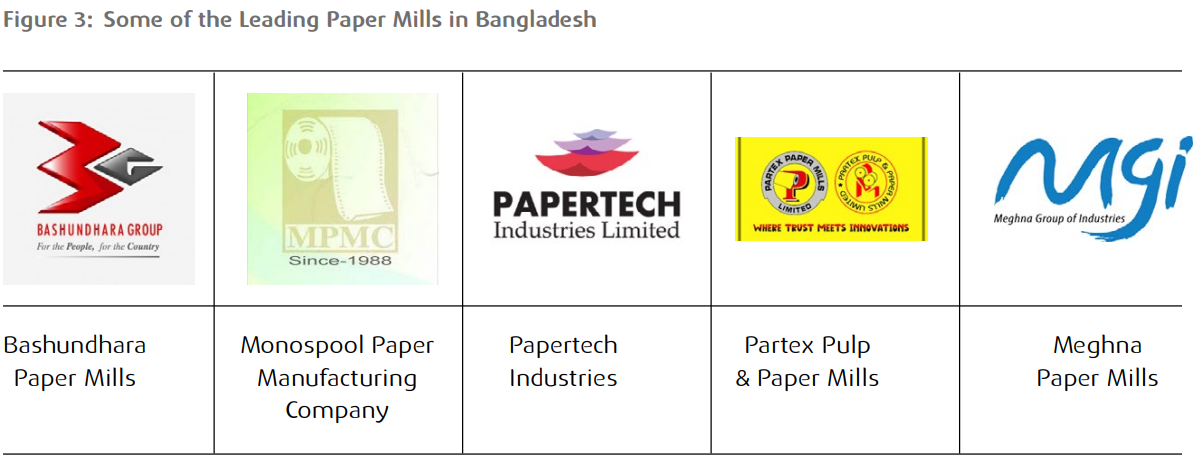Scripting Export Narratives: Leaving a Domestic Paper Trail in Global Markets
Written By Syed Md. Rakeen, Team MBR
Bangladesh is currently navigating through rocky roads and finding itself in a dicey situation with continuous depletion of foreign reserves and a dollar crisis leading to skyrocketing prices of imports. Amidst all the economic uncertainties, the paper and paper products industry is generating optimism amidst a period of declining export earnings for the country’s manufacturing sector products and is currently displaying itself as one of the few bright sparks in the export segments for Bangladesh. Its meteoric rise in recent years can be attributed to the widespread necessity of paper products in both local and foreign countries. Albeit paper manufacturing is largely synonymous with heavy imports of raw materials, i.e. pulps, the recent surge in paper exports tells a different tale as Bangladesh gained considerable ground in this space. Particularly, the private paper mills have leapt ahead of the government-owned paper mills in catering to the local as well as the foreign demand for high-quality paper products with their modern technologies. According to the Bangladesh Paper Mills Association (BPMA), almost 70 private paper mills are currently in operation among the 105 paper mills in Bangladesh with a combined annual production capacity of more than 15 lakh metric tonnes of paper products.
The Paper Industry’s Rise to Prominence
The inception of the local paper industry can be traced back to the 1980s, when it initially operated on a modest scale. However, during the 1990s, a surge in investors’ interest resulted in massive capital inflows, propelling the industry towards self-sufficiency. As reported by The Business Standard, the market size of the paper market in the country currently amounts to BDT 5,000 crore. The paper mills within the country are presently engaged in exporting their products while fulfilling domestic demand and employing approximately 1.5 million people.

As Figure 2 shows, the exports figures remained relatively stagnant during fiscal years 2018–19 and 2019–20 but experienced a sharp downfall during fiscal year 2020–21 owing to the rise of the COVID-19 pandemic, which reduced the usage of papers across educational institutions and offices. The industry’s resilience in the following fiscal year is a strong indication of its promise, with figures of USD 105.1 million in fiscal year 2021–22, followed by over 100% growth during fiscal year 2022–23. Most recently, Bangladesh has demonstrated an exponential rise in the exports of papers and paper products, with figures reaching USD 39.79 million during July– August of the current fiscal year and experiencing 85% year-on-year growth, according to the Export Promotion Bureau.
The local market is predominantly comprised of writing and printing paper products, which constitute approximately 60–70% of the total demand for paper products. The Bangladesh Paper Manufacturers Association reported that BDT 70,000 crore has been invested by entrepreneurs in the paper industry so far, enabling the paper mills to achieve an annual production capacity of 15 lakh metric tonnes. The local demand for paper products is estimated to be around 6 lakh metric tonnes, indicating a surplus of 9 lakh metric tonnes, which are then exported.
The vastness of the industry is evident through its broad range of sub-industries and ancillary industries, totaling approximately 300. Some of these include printing, publishing, ink making, decoration, packaging, and binding. These industries are closely intertwined with the sector, contributing to its overall functioning and value chain.
Underlying Reasons Behind the Exponential Rise in Exports
Industry sources suggest that the rate of exports experienced a surge shortly after the implementation of a government initiative in 2016 to provide a 10% cash incentive on receipts. According to the BPMA, the United States, along with countries in Europe, Middle East, and Africa, serve as the primary export destinations for domestically manufactured papers and paper products. Besides, Bangladesh is strategically leveraging the scarcity of supply resulting from decreased production in prominent sourcing destinations like China, India, and Japan owing to environmental concerns.
Additionally, China, India, and Japan are leaning towards investment in hi-tech industries, which has paved the path for Bangladesh to seize the opportunity and ensure a much bigger market share of the global paper market. This transition, along with government policy support and the dedication of producers, has played a significant role in driving the growth of this industry over the course of several years.


The local and global market dynamics suggest that firms engaged in product diversification possess the potential to cater to a much larger customer base. This, in turn, led some of the entrepreneurs in the paper industry to shift their attention from paper manufacturing to diversifying paper products, while others are planning to fixate entirely on diversified products.
The domestic tissue market experienced a significant growth rate of 100% over a span of ten years, primarily attributed to the rapid process of urbanisation, an increase in per capita income, and a heightened awareness of hygiene practices among consumers. The annual production capacity followed suit, rising from 30,000 metric tonnes in the fiscal year 2016– 2017 to approximately 84,000 metric tonnes as of November 2022.
Major Market Players in the Paper Industry
The likes of Bashundhara Paper Mills, Monospool Paper Manufacturing Company, Partex Pulp & Paper Mills, Meghna Paper Mills, and Papertech Industries had managed to capture a large market share domestically and establish a prominent presence in the industry. Additionally, the increase in the price of paper products has played a significant role in the success of this industry. This enabled the industry leader, Bashundhara Paper Mills, to generate higher revenues and improve its profitability. By effectively managing costs and optimising production processes, the company managed to navigate the challenges posed by rising prices and maintain a competitive edge.
Till now, the paper mills in Bangladesh have comfortably met the local demand while broadening their export base across multiple countries at the same time.

Monospool Paper Manufacturing Company, a concern of Magura Group, which generates around BDT 66 crore in revenue, is among the top paper mills, after Bashundhara Paper Mills. The company is scheduled to merge with Pearl Paper & Board Mills, another Magura Group firm. Following the merger of the two businesses, Monospool Paper’s income is expected to reach a whopping BDT 350 to BDT 400 crore.
Diversification of Paper Products
The paper and paper-goods sector encompasses various types of paper products, such as writing and printing papers, offset papers, newsprints, tissues, and packaging papers. Bangladesh has demonstrated commendable progress in the paper manufacturing sector, particularly in the production of paper-based commodities such as tissue papers, toilet papers, facial tissues, napkins, and diapers. This has translated to buyers consistently exhibiting a keen interest in procuring paper products of commendable quality at competitive prices. Paper mills have strategically developed a diversified range of tissue products, catering to various consumer needs and preferences. By diversifying their product portfolio, paper mills have tapped into new market segments and expanded their customer base. This strategic move has not only boosted sales but also enhanced the brand image and reputation of paper mills in Bangladesh.
Waste Paper Processing Industry
Lipy Paper Mills recently decided on investing in waste paper processing with the objective of mitigating reliance on imported raw materials, specifically pulp. The ongoing endeavour at the factory located in Sonargaon involves the implementation of state-of-the-art machinery to facilitate the processing of discarded paper and subsequently recycle it for future uses. Bashundhara Paper Mills, Base Papers, Meghna Pulp, and Paper Mills, along with several other mills, are actively involved in the paper recycling industry. However, the quantity of waste paper recycled by these mills is insufficient in relation to the prevailing demand. The current market exhibits a significant surge in demand for recycled waste paper, which serves as a valuable raw material in paper mills.

Hindrances on the Horizon
A huge concern revolves around the escalating cost of pulp, primarily attributed to a scarcity in supplies, with Bangladesh heavily reliant on imports for approximately 90% of the pulp it consumes. Besides, the current predicament faced by the paper industry revolves around the challenges encountered in the process of initiating necessary letters of credit (LCs) in order to fulfil the growing demand for raw materials. The paper industry experienced a significant setback due to the prolonged closure of educational institutions and offices in response to the global outbreak of the COVID-19 pandemic in 2020 and 2021. The industry encountered yet another setback due to disruptions in the supply chain and a significant surge in raw material prices within the global market because of the Russia-Ukraine war. The demand for paper products, especially those that are diversified in nature, has encountered disruptions regarding raw material imports due to a severe dollar crisis.
In a bid to respond to growing raw material prices, recycling the disposed paper waste has emerged as a way of reducing the reliance on imports. There are approximately 40 tonnes of waste paper generated for every 100 tonnes of paper that is sold. The potential for cost savings can be realised through the local recycling of waste paper.

The National Curriculum and Textbook Board (NCTB) has encountered challenges in the dissemination of books, primarily attributable to the escalating cost of papers and the scarcity of pulps. The National Council of Textbook and Curriculum Development implemented a strategy wherein they provided paper mills with their own surplus inventory of outdated books. The used papers have undergone a recycling process, resulting in the production of fresh paper materials. This newly generated paper has subsequently been employed for the printing of the latest editions of textbooks published by the National Curriculum and Textbook Board.
According to the Globe Newswire, the global market size for the paper industry was USD 354.39 billion in 2022. Besides, there is a perceived need for increased competitiveness in pricing, particularly within the United States and European markets. The industry holds significant potential for improvement if additional policy support is provided. Despite the global market leaning more towards a paperless economy in the next decade, the importance of different paper products apart from writing or printing paper will only incrementally grow in the forthcoming years. Other segments within the paper industry, such as tissue and hygiene products, have displayed resilience and are exhibiting robust growth patterns. Especially, the increasing awareness of hygiene has prompted the sector to elevate itself in a short period of time. Amidst the shutdown of paper mills across China due to environmental concerns, Bangladesh can hope to elevate the paper industry to new heights by increasing its global market share while simultaneously focusing on addressing climate issues. All in all, the paper and paper products industry seems destined to succeed, with its massive export figures already providing Bangladesh some breathing space to develop another key source of foreign earnings.

Scripting Export Narratives: Leaving A Domestic Paper Trail In Global Markets
Bangladesh is currently in a precarious position due to rising import prices and dwindling foreign currency reserves. Amidst the uncertainties, the paper and paper products industry has emerged as a key source of foreign earnings in recent years, with the sector recording an 85% year-on- year growth during July-August of FY 2023- 24 relative to FY 2022-23.
The market size of paper and paper-allied products is estimated to be BDT 5,000 crore, with the industry comprising diverse paper products, including writing and printing papers, offset papers, newsprints, tissues, and packaging papers. The industry was largely boosted back in 2016, owing to the government’s cash incentive of 10% on receipts. Till now, Bangladesh has been exporting its paper-allied products to over 50 nations, including the United States and countries from Europe, the Middle East, and Africa.
As the world edges closer towards a paperless economy, the demand for writing and printing paper is expected to experience a sharp downfall, while the heavy reliance on paper pulp imports and its scarcity will trigger an increase in the prices of paper products. However, these challenges have been addressed adequately, as paper mills have invested in waste paper processing to reduce reliance on imported raw materials while prioritising product diversification to cater to foreign demands. An excellent opportunity awaits Bangladesh, as the decreased paper manufacturing of China, India and Japan can propel the paper industry to new heights and establish itself as one of the paper manufacturing hubs in the world.
Md. Shah Jalal
Editor
IDLC Monthly Business Review
Download View